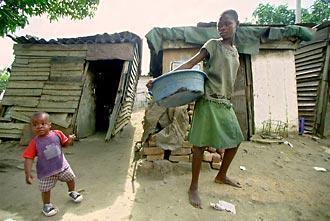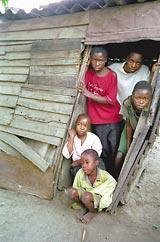|
WHEN A FEMALE CONDOM called the Care Contraceptive Shield was introduced in Zimbabwe in 1997, sales were forecast at 4,000 a month. In the first four months, more than 95,000 were sold.
Sales subsequently dropped, but a recent survey shows female condoms have found a niche among women in their mid- to late-20s who are relatively well-educated, well-off and the primary wage-earners in their households.
The user profile does not fit Ruth.
· · · · · · · · · · · · · · · · · · · · · · · · · · · · · · · · · · · · · · · · · · · · · · · · · · ·
ON SUNDAY, a message is slipped under the hotel room door.
Marvelous telephoned. Please call back. Ruth has passed away.
Throughout sub-Saharan Africa, some 11 million children have been orphaned by AIDS.
By 2010, the number will be 40 million.
|
· · · · · · · · · · · · · · · · · · · · · · · · · · · · · · · · · · · · · · · · · · · · · · · · · · ·
 |
| BETTY UDESEN / THE SEATTLE TIMES |
| Throughout sub-Saharan Africa, some 11 million children have been orphaned by AIDS.
Linda Chitima, 14, is one of five siblings who lost both their parents to the virus. She
carries a basin to a neighboring house for water to finish the laundry before church
begins. Her dream is to be an "air hostess" when she grows up. |
|
 |
 |
EVEN IN THE DEEP PIT of human suffering, there is a hierarchy.
Ruth's children have grandparents and aunts to love and care for them. The five AIDS orphans of Mufakose have only themselves.
Each township — known here as a "high-density area" — is famous for something. Mabvuku, where Ruth lives, is noted for its fertile red earth. Mbare is the oldest township, known for its bazaar, soccer players and world-class musician Thomas Mapfumo. Epworth boasts politicians and the balancing rocks depicted on Zimbabwe's bank notes. Chitungwiza is praised for its sculptors.
Mufakose, where the orphans live, loosely translates as "suffering from all sides," a name that likely evolved decades ago during the war for liberation. It still seems apt today.
The five siblings live in a plank shack with a dirt floor and no running water. No electricity. No hinges on a door that hangs, lopsided, from wire loops. A white plastic bucket holds their only food — a few handfuls of grain called mealy-meal.
 |
 |
| BETTY UDESEN / THE SEATTLE TIMES |
| In the Zimbabwean township of Mufakose, five AIDS orphans share a tiny plank shack with only a carpet scrap for a bed. Clockwise from bottom: King, 6; Grace, 12; Leonard 17; Lovemore, 21; Linda, 14. Lovemore wants to be a minister, but instead scrounges for food to feed his siblings. |
|
 |
Still, their Sunday clothes are washed and wrinkle-free in time for church. This is especially amazing when you consider that in Zimbabwe, where dress is formal and appearance important, those who don't own irons press their garments under mattresses. The orphans don't have a mattress.
They sleep, shoulder to shoulder, on a scrap of carpet laid over pitted earth, girls on one side, boys on the other, baby brother King in the middle. It's good the ground is uneven, they say, because when rain floods the shack, the water drains away from their bodies.
King Chitima is 6 years old and likes to play with rocks.
Grace is 12 and wants to be a nurse so she can care for sick people, feeding them porridge as she once fed her mother.
Linda, 14, dreams of serving passengers as an air hostess even though she has never flown.
Leonard, 17, wants to be president of Zimbabwe so he can learn foreign languages, make friends in other countries and help his people.
Lovemore is 21. In an ideal world, he'd be a pastor because he loves to worship and do the work of God. In a merely normal world, he would be an engineer, but he failed his exams after he left school to care for his sick mother. If life was only mildly bad, he'd look for work as a mechanic, since he's earned a certificate in that field.
In reality, the five orphans are clinging to the lower rungs of the Ladder of Unluck, so Lovemore does whatever he can to scrounge a living in a place suffering from all sides. There is little work to be had. The government's corrupt and ill-conceived plan to redistribute farmland means not much maize was planted or harvested this year. Store shelves are empty, so food vouchers from a welfare agency are of no use. A few commodities are sold at exorbitant prices on the black market. Five kilos of mealy-meal cost 1200 Zimbabwean dollars (less than $5 U.S.) — double the price of three months ago.
"Every little bit, if you make any difference at all, is going to help. I think you’re morally obliged to look at anything and everything that has any potential."
— DR. NANCY PADIAN, WOMEN’S GLOBAL HEALTH IMPERATIVE |

|
 |
 |
 |
 |
 |
Sometimes Lovemore earns money digging neighbors' gardens. Sometimes friends share their food. Most often, the children go hungry.
How often?
"Always."
The girls are especially thin, and in the warped Western aesthetic that celebrates starved supermodels, Grace and Linda look ethereally beautiful.
This is worrisome because orphan girls are easy targets for rape. Fortunately, Lovemore is known as being strict and strong, a neighbor says, so men don't tangle with his sisters. Fortunately, local tastes are for fleshy beauties with ample buttocks and breasts.
In many sub-Saharan countries,
the probability that a teenager living today will die of AIDS is greater than 50 percent.
|
|